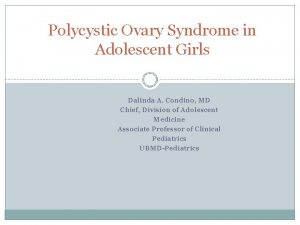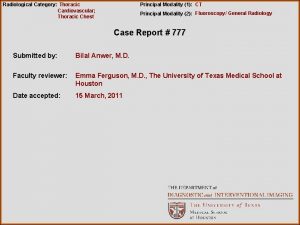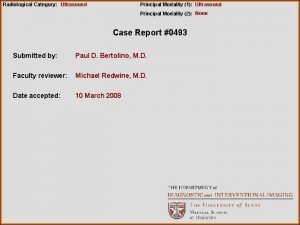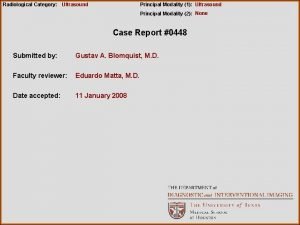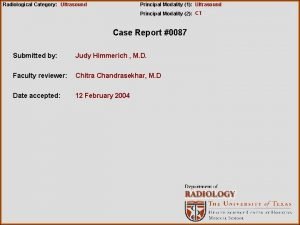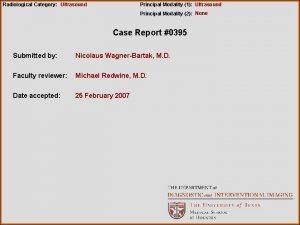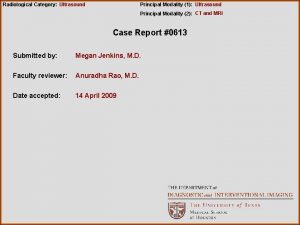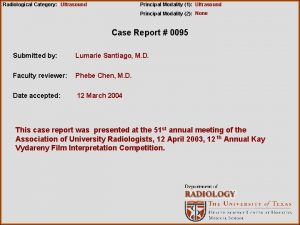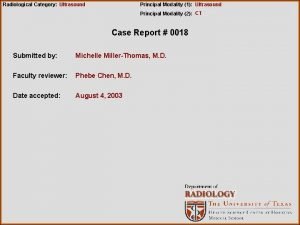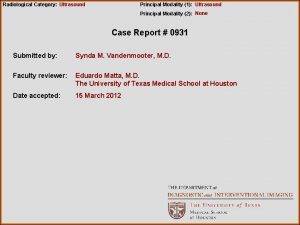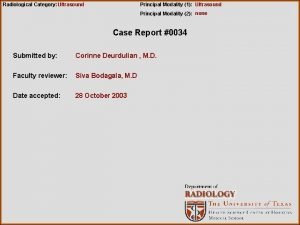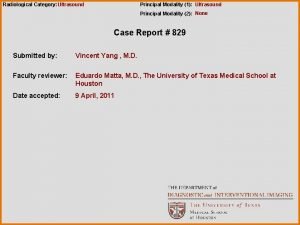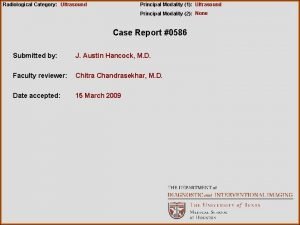Radiological Category Thoracic Chest Principal Modality 1 Ultrasound














- Slides: 14

Radiological Category: Thoracic Chest Principal Modality (1): Ultrasound Principal Modality (2): None Case Report #0084 Submitted by: Neil Bhargava, M. D. Faculty reviewer: Valerie Kirkby, M. D. Date accepted: 13 January 2004

Case History Large palpable thyroid nodule.

Radiological Presentations

Radiological Presentations

Radiological Presentations

Test Your Diagnosis Which one of the following is your choice for the appropriate diagnosis? After your selection, go to next page. • Multinodular Goiter • Papillary Thyroid Carcinoma with Lymphadenopathy • Grave’s Disease

Findings and Differentials Findings: Figure 1: The thyroid gland is enlarged. The normal homogeneous appearance of the thyroid parenchyma is replaced by a heterogeneous appearance with scattered punctate calcifications, some of which exhibit posterior acoustic shadowing. Figure 2: Hypervascularity of the gland is noted on Doppler flow studies. Figure 3: Heterogeneous enlarged cervical lymph nodes with areas of fine calcification. Differentials: • Papillary Thyroid Cancer • Other Types of Thyroid Cancer

Discussion THYROID ANATOMY / ULTRASOUND CHARACTERISTICS • The thyroid gland consists of two lobes and an isthmus. It is located in the infrahyoid compartment of the neck along the anterior and anterolateral aspect of the trachea. A pyramidal lobe, located superior to the isthmus, is present in 1040% of individuals. The pyramidal lobe atrophies in adulthood, and is thus better visualized in younger adults. • The normal thyroid parenchyma has a homogenous medium- to high-level echogenicity on ultrasound. The capsule is usually visualized as a thin hyperechoic line surrounding the thyroid parenchyma. The gland’s hypervascularity is most prominent in the superior and inferior poles. The surrounding musculature is seen as thin, hypoechoic bands. The sternohyoid and omohyoid muscles are seen anteriorly, the sternocleidomastoid laterally, and the longus colli posteriorly. The recurrent laryngeal nerve and inferior thyroid artery are located in the angle between the trachea, esophagus and thyroid lobe.

Discussion PAPILLARY THYROID CARCINOMA / BACKGROUND: • Most primary thyroid cancers are derived from either follicular or parafollicular cells, with papillary carcinoma accounting for the majority of cases (75 -90%). Papillary cancer is most prevalent in younger individuals, and there is a female predominance. The tumor is multicentric on microscopy in 20% of cases. Round, laminated calcifications (psammoma bodies) are present in 25% of cases. Spread occurs via the lymphatics to regional cervical lymph nodes. Distant metastases are very rare and occur mostly in the mediastinum and lung. The mortality is between 4 -8% after 20 years.

Discussion PAPILLARY THYROID CARCINOMA / IMAGING: • Ultrasound findings are typically characteristic. Masses are hypoechoic with microcalcifications appearing as tiny punctate hyperechoic foci with variable acoustic shadowing. Eggshell or large and coarse calcifications tend to be benign. Disorganized hypervascularity is commonly seen on Doppler examination. Lymph node metastasis may either have a similar appearance with microcalcifications or occasionally may be cystic from extensive degeneration. Cystic papillary carcinomas often have an identifiable solid projection with the above features.

Discussion WORKUP OF A CLINICALLY DETECTED THYROID NODULE: • Fine needle aspiration (FNA) biopsy is the most effective method for diagnosing malignancy. It can usually be performed by direct palpation. Isotope or sonographic imaging is not routinely used. Not surprisingly, FNA is dependent on the experience of the aspirationist and the expertise of the cytopathologist. Limitations include lack of specificity in results that are suspicious for malignancy as follicular or Hurthle cell adenomas appear similar to their malignant counterparts. FNA has a sensitivity range of 60 -98%, and a specifity of 72 -100%. Ultrasound FNA is employed when there is a questionable nodule by physical examination or if a nondiagnostic or inconclusive biopsy returned after FNA performed under direct palpation.

Discussion WORKUP OF A CLINICALLY DETECTED THYROID NODULE: • Although FNA has become the primary diagnostic method for evaluating palpable thyroid nodules, High resolution sonography is used to detect other thyroid or cervical masses prior to and after thyroidectomy, characterization of features (benign versus malignant), and FNA guidance. It is also used in screening highrisk patients (e. g. family history or MEN-II syndrome, prior neck irradiation). Sonography of a known cancer is not usually performed prior to thryroidectomy, but can be useful in large tumors to assess for invasion or encasement of adjacent structures such as the carotid artery or internal jugular veins. Sonography is often used after partial thyroidectomy to evaluate for recurrent, residual or metastatic disease.

Discussion WORKUP OF THE INCIDENTALLY DETECTED NODULE: • Commonly seen in the course of carotid, parathyroid or other examinations of the neck. Up to 50% of individuals have nodules that can be detected sonographically, but the incidence rate of clinically apparent cancer (e. g. palpable) is 0. 005%. The majority of clinically apparent cancer is curable. Therefore the need for further diagnostic workup (e. g FNA) of impalpable nodules should proceed only if malignant features are present, or the nodule is greater than 1. 5 cm. Nodules under 1. 5 cm can be safely followed by palpation clinically.

Diagnosis Pathology: Fine needle aspiration and subsequent thyroidectomy revealed papillary thyroid cancer with involvement of the cervical lymph nodes. Reference: Diagnostic Ultrasound. Second Edition. Rumack CM, Wilson SR, Charboneau JW. Chapter 21 The Thyroid Gland. Mosby. Pp 703 -723.
 Pcos ultrasound image
Pcos ultrasound image Erate category 2
Erate category 2 Radiological dispersal device
Radiological dispersal device Tennessee division of radiological health
Tennessee division of radiological health Center for devices and radiological health
Center for devices and radiological health National radiological emergency preparedness conference
National radiological emergency preparedness conference Birafs
Birafs Modality in statistics
Modality in statistics Modality
Modality Modality in software engineering
Modality in software engineering Deontic and epistemic modality exercises
Deontic and epistemic modality exercises Modality in software engineering
Modality in software engineering Data modeling fundamentals
Data modeling fundamentals Modality
Modality Low modality examples
Low modality examples
